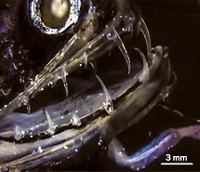Advertisement
Grab your lab coat. Let's get started
Welcome!
Welcome!
Create an account below to get 6 C&EN articles per month, receive newsletters and more - all free.
It seems this is your first time logging in online. Please enter the following information to continue.
As an ACS member you automatically get access to this site. All we need is few more details to create your reading experience.
Not you? Sign in with a different account.
Not you? Sign in with a different account.
ERROR 1
ERROR 1
ERROR 2
ERROR 2
ERROR 2
ERROR 2
ERROR 2
Password and Confirm password must match.
If you have an ACS member number, please enter it here so we can link this account to your membership. (optional)
ERROR 2
ACS values your privacy. By submitting your information, you are gaining access to C&EN and subscribing to our weekly newsletter. We use the information you provide to make your reading experience better, and we will never sell your data to third party members.
Biomaterials
Dragonfish pierce prey with transparent, nanostructured teeth
Nanoscale structures reduce light scattering, making the saber-like teeth virtually invisible in the deep sea
by Bethany Halford
June 9, 2019
| A version of this story appeared in
Volume 97, Issue 23

The deep-sea dragonfish Aristostomias scintillans lurks 500 m beneath the ocean’s surface, where the only visible light comes from bioluminescence. The creatures are only about 15 cm long, but they are voracious predators capable of eating fish up to half their size. These dragonfish lure their prey with glowing photophores along their dark, sleek bodies and with a light-producing barbel that sprouts from their chins. What unsuspecting prey do not see when they approach the dragonfish are the long, spiky teeth protruding from their gaping jaws. That’s because in the deep sea these teeth are transparent, thanks to nanoscale structures that reduce light scattering (Matter 2019, DOI: 10.1016/j.matt.2019.05.010). Researchers led by Marc A. Meyers of the University of California, San Diego, studied the dragonfish’s saber-like teeth and found that they are made of a highly mineralized enamel-like layer consisting of 20 nm crystals of hydroxyapatite in an amorphous matrix of enamel. This layer surrounds the tooth’s dentin, which is made of an array of collagen nanofibrils (5 nm in diameter) embedded in a hydroxyapatite matrix. These nanostructures don’t reflect or scatter light underwater, effectively making the teeth invisible. The researchers hope to make materials inspired by these teeth using nanocrystals and ceramics.





Join the conversation
Contact the reporter
Submit a Letter to the Editor for publication
Engage with us on Twitter